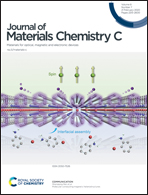A bis(diketopyrrolopyrrole) dimer-containing ligand in platinum(ii) polyyne oligomers exhibiting ultrafast photoinduced electron transfer with PCBM and solar cell properties†
Abstract
Two polyyne oligomers using the thiophene–(diketopyrrolopyrrole)–thiophene unit, T–DPP–T, and the organometallic synthon trans-Pt(PBu3)2(C![[triple bond, length as m-dash]](https://www.rsc.org/images/entities/char_e002.gif) C)2, [Pt], ([L1]–[Pt])m (P1), here used for comparison purposes, and ([L4]–[Pt])m (P4), where L1 and L4 are T–DPP–T and (T–DPP–T)2, respectively, were synthesized by CuI-catalyzed dehydrohalogenation and fully characterized. The optical and electrochemical properties were investigated by UV-visible absorption and cyclic voltammetry, and P4 was found to exhibit a very low band gap. DFT (density functional theory) and TD-DFT (time-dependent DFT) computations were undertaken to address the polymers’ geometry, their electronic structures and calculated HOMO and LUMO energies. The S1 level is best described as a ππ* excited state. P1 and P4 exhibit fluorescence lifetime in ps timescale and the fs-TAS data indicate an ultrafast electron transfer to PC61BM ((1Px* + PC61BM → Px+˙ + (PC61BM)−˙; time scale < 113–128 fs) evidenced by an increased formation of the triplet state upon back electron transfer (Px+˙ + (PC61BM)−˙) → 1,3Px* + PC61BM; x = 1, 4). The timescale of recombination for P4 (P4+˙ + (PC61BM)−˙ → 3P4* + PCBM) is found to be ∼3 ps. The photovoltaic performance of Px was investigated by fabricating the photovoltaic solar cells (PSCs) with conventional device structure ITO/PEDOT:PSS/(P1 or P4):PC71BM/PFN/Al. After solvent vapour annealing with THF, the power conversion efficiencies, PCEs, are 7.36% (P1; Jsc = 12.94 mA cm−2, Voc = 0.92 V, FF = 0.62) and 9.54% (P4; Jsc = 16.24 mA cm−2, Voc = 0.89 V, FF = 0.66). The higher PCE of P4 may be related to the faster extraction and longer charge carrier lifetime for P4 based PSCs as compared to P1.
C)2, [Pt], ([L1]–[Pt])m (P1), here used for comparison purposes, and ([L4]–[Pt])m (P4), where L1 and L4 are T–DPP–T and (T–DPP–T)2, respectively, were synthesized by CuI-catalyzed dehydrohalogenation and fully characterized. The optical and electrochemical properties were investigated by UV-visible absorption and cyclic voltammetry, and P4 was found to exhibit a very low band gap. DFT (density functional theory) and TD-DFT (time-dependent DFT) computations were undertaken to address the polymers’ geometry, their electronic structures and calculated HOMO and LUMO energies. The S1 level is best described as a ππ* excited state. P1 and P4 exhibit fluorescence lifetime in ps timescale and the fs-TAS data indicate an ultrafast electron transfer to PC61BM ((1Px* + PC61BM → Px+˙ + (PC61BM)−˙; time scale < 113–128 fs) evidenced by an increased formation of the triplet state upon back electron transfer (Px+˙ + (PC61BM)−˙) → 1,3Px* + PC61BM; x = 1, 4). The timescale of recombination for P4 (P4+˙ + (PC61BM)−˙ → 3P4* + PCBM) is found to be ∼3 ps. The photovoltaic performance of Px was investigated by fabricating the photovoltaic solar cells (PSCs) with conventional device structure ITO/PEDOT:PSS/(P1 or P4):PC71BM/PFN/Al. After solvent vapour annealing with THF, the power conversion efficiencies, PCEs, are 7.36% (P1; Jsc = 12.94 mA cm−2, Voc = 0.92 V, FF = 0.62) and 9.54% (P4; Jsc = 16.24 mA cm−2, Voc = 0.89 V, FF = 0.66). The higher PCE of P4 may be related to the faster extraction and longer charge carrier lifetime for P4 based PSCs as compared to P1.



 Please wait while we load your content...
Please wait while we load your content...